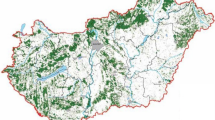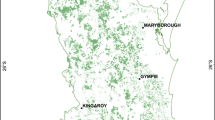Abstract
In this study, we estimated the technoeconomic availability of three types of dead trees, namely commercially fallen, normally fallen, and standing, in Mongolian subgroups. For dead trees of three major Mongolian tree species (Siberian larch, Scotch pine, and Asian white birch), lumber, firewood, and unused material as sources of energy were quantified and operational costs (marking, felling, skidding, transporting, loading/unloading, processing, and stumpage prices) were estimated. As a result, most Mongolian subgroups were profitable and suitable for the harvest of unused materials. Moreover, unused materials of dead trees can substitute nearly 5.45 million tons of coal, although it is not sufficient to meet the 0.6 years of coal demand across Mongolia. However, in some places, unused dead wood materials can completely substitute coal for decades. Therefore, although the heat utilization of woody biomass is not suitable for Mongolia as a whole, it is feasible in specific regions where forest resources are abundant, such as some Mongolian sub-provinces. Promoting the use of dead trees can reduce the risk of damage caused by wildfires and pests, which are serious problems in Mongolia, and keep the forests healthy. Furthermore, unused materials can generate new income opportunities, and the forest land can be well prepared by removing dead trees to promote planting for sustainable forest management. Finally, dead trees can be used as a resource until transition to sustainable forests with living trees.











source of energy at each sub-provincial center

Similar content being viewed by others
Data availability statement
Restrictions apply to the availability of these data. Data was obtained from the Government of Mongolia and are available with the permission of the Government of Mongolia.
References
Agency for Natural Resources and Energy of Japan. (2020). https://www.enecho.meti.go.jp/statistics/total_energy/carbon.html. (Accessed 10 Jan 2021).
Allen, R. W., Gombojav, E., Barkhasragchaa, B., Byambaa, T., Lkhasuren, O., & Amram, O. (2013). An assessment of air pollution and its attributable mortality in Ulaanbaatar, Mongolia. Air Quality, Atmosphere and Health, 6, 137–150. https://doi.org/10.1007/s11869-011-0154-3
Altrell, D. (2019). Multipurpose National Forest Inventory in Mongolia, 2014–2017 - A tool to support sustainable forest management. Geography, Environment, Sustainability, 12, 167–183. https://doi.org/10.24057/2071-9388-2019-36.
Baasan, B., & Mohns, B. (2019). Final completion report on ADB Project: Sustainable Forest Management to Improve the Livelihood of Local Communities (SFM). Ulaanbaatar, Mongolia: Mongolian University for Science and Technology (MUST).
Battuvshin, B., Matsuoka, Y., Shirasawa, H., Toyama, K., Hayashi, U., & Aruga, K. (2020). Supply potential and annual availability of timber and forest biomass resources for energy considering inter-prefectural trade in Japan. Land Use Policy, 97, 1–12. https://doi.org/10.1016/j.landusepol.2020.104780
Battuvshin, B., & Stritzke, M. (2015). Time and cost estimation for forestry activities. GIZ-Program report, Ulaanbaatar, Mongolia.
Dashdemberel, S., Sonomjamts, M., & Gombojav, D. (2012). Lung function measurements of adults in Ulaanbaatar city, Mongolia. Chest, 142, 754A. https://doi.org/10.1378/chest.1359714
Doosan Solar 55V. (2003). https://machine.market/specification-21164. (Accessed 10 Jan 2021).
Dorjsuren, C. H. (2014). Forest ecosystems (in climate change impact and exposure). Mongolia second assessment report on climate change – MARCC. Ulaanbaatar, Mongolia. 94–100.
Dulamsuren, C., Klinge, M., Degener, J., Khishigjargal, M., Chenlemuge, T., & Bat-Enerel, B. (2016). Carbon pool densities and a first estimate of the total carbon pool in the Mongolian forest–steppe. Global Change Biology, 22, 830–844. https://doi.org/10.1111/gcb.13127
Eker, M., Spinelli, R., & Gurlevik, N. (2017). Recovering energy biomass from sustainable forestry using local labor resources. Journal of Cleaner Production, 157, 57–64. https://doi.org/10.1016/j.jclepro.2017.04.134
Energy Regulation Commission. (2019). Statistics on Energy Performance 2019. https://erc.gov.mn/web/en/contents/19. (accessed 10 January 2021).
FAO. (2020). Global Forest Resources Assessment 2020 Report Mongolia. http://www.fao.org/3/cb0031en/cb0031en.pdf. (Accessed 10 Jan 2021).
Forestry Agency of Japan. (2013). https://www.rinya.maff.go.jp/j/kaigai/cdm/pdf/h24cdmreport-info-1.pdf. (Accessed 10 Jan 2021). [in Japanese]
Furubayashi, T., & Nakata, T. (2018). Cost and CO2 reduction of biomass co-firing using waste wood biomass in Tohoku region, Japan. Journal of Cleaner Production, 174, 1044–1053. https://doi.org/10.1016/j.jclepro.2017.11.041
Glauner, R., & Dugarjav, D. (2018). Assessment of wood product value chains and recommendations for the mongolian wood-processing industry. http://reddplus.mn/eng/wp-content/uploads/2018/09/UNDP-Wood-Product-Value-Chains.pdf. (Accessed 10 Jan 2021).
Gradel, A., & Petrow, W. (2014). Forstpolitische Entwicklungen im Transformationsland Mongolei. AFZ-Der Wald, 17, 36–39. [in German].
Gradel, A., Sukhbaatar, G., Karthe, D., & Kang, H. (2019). Forest management in Mongolia - a review of challenges and lessons learned with special reference to degradation and deforestation. Geography, Environment, Sustainability, 12, 133–166. https://doi.org/10.24057/2071-9388-2019-102.
Kamimura, K., Kuboyama, H., & Yamamoto, K. (2012). Wood biomass supply costs and potential for biomass energy plants in Japan. Biomass and Bioenergy, 36, 107–115. https://doi.org/10.1016/j.biombioe.2011.10.020
Kanematsu, Y., Oosawa, K., Okubo, T., & Kikuchi, Y. (2017). Designing the scale of a woody biomass CHP considering local forestry reformation: A case study of Tanegashima, Japan. Applied Energy, 198, 160–172. https://doi.org/10.1016/j.apenergy.2017.04.021
Karthe, D., Hafer, T., Battulga, B., Sereeter, L., & Stehr, G. (2020). Pollution reduction potential by implementing electrostatic dust precipitators on Mongolian small-scale stoves (a pilot study in Ulaanbaatar). Geogr. Environ. Sustain., 13, 117–128. https://doi.org/10.24057/2071-9388-2020-50.
Karthe, D., Heldt, S., Houdret, A., & Borchardt, D. (2015). IWRM in a country under rapid transition: Lessons learnt from the Kharaa River Basin, Mongolia. Environment and Earth Science, 73, 681–695. https://doi.org/10.1007/s12665-014-3435-y
Khishigjargal, M., Dulamsuren, C. H., Leuschner, H. H., Leuschner, C., & Hauck, M. (2014). Climate effects on inter- and intra-annual larch stemwood anomalies in the Mongolian forest-steppe. Acta Oecol, 55, 113–121. https://doi.org/10.1016/j.actao.2013.12.003
Kumazaki, M., & Sawabe, O. (2013). Mokushitsu Shigen Tokoton Katsuyo Dokuhon. Nosongyoson Bunkakyokai. [in Japanese].
Matsuoka, Y., Shirasawa, H., Hayashi, U., & Aruga, K. (2021). Annual availability of forest biomass resources for woody biomass power generation plants from subcompartments and aggregated forests in Tohoku region of Japan. Forests, 12, 1–15. https://doi.org/10.3390/f12010071
Menzel, L., Hofmann, J., & Ibisch, R. (2011). Untersuchung von Wasser- und Stoffflüssen als Grundlage für ein Integriertes Wasserressourcen – Management im Kharaa-Einzugsgebiet (Mongolei). Hydrol Wasserbewirts, 55, 88–103. [in German].
MET. (2017). Report on the state of the environment of Mongolia 2015–2016. Ulaanbaatar, Mongolia: Ministry of Environment and Tourism. [in Mongolian].
MET. (2018). Mongolia’s Forest Reference Level submission to the United Nations Framework Convention on Climate Change. UN-REDD Mongolia National Programme. http://reddplus.mn/eng/wp-content/uploads/2018/08/2018-Mongolia-FRL-modified-2.pdf. (Accessed 10 Jan 2021).
MET. (2019). Mongolian Multipurpose National Forest Inventory 2014–2017 (2nd ed.). Ministry of Environment and Tourism.
Ministry of Energy. (2018). Energy Sector of Mongolia. Country Report for JICA Knowledge Co-Creation Program Energy Policy 2018. https://eneken.ieej.or.jp/en/whatsnew/countryreport2018en.html. (Accessed 10 Jan 2021).
Ministry of Foreign Affairs of Japan. (2021). https://www.mofa.go.jp/mofaj/area/mongolia/data.html. (Accessed 10 Jan 2021).
Nakahata, C., Aruga, K., Uemura, R., Saito, M., & Kanetsuki, K. (2014). Examining the optimal method to extract logging residues from small-scale forestry in the Nasunogahara area, Tochigi prefecture, Japan. Small-Scale Forestry, 13, 251–266. https://doi.org/10.1007/s11842-013-9252-4
NIRAS. (2018). Project completion report on ADB Project: Sustainable forest management to improve the livelihood of local communities (TA 8874 MON). Ulaanbaatar, Mongolia.
Nord-Larsen, T., & Talbot, B. (2004). Assessment of forest-fuel resources in Denmark: Technical and economic availability. Biomass and Bioenergy, 27, 97–109. https://doi.org/10.1016/j.biombioe.2004.01.007
Oyuntuya, S. H., Dorj, B., Shurentsetseg, B., & Bayarjargal, E. (2015). Agrometeorological information for the adaptation to climate change. In N. B. Badmaev, C. B. Khutakova (Eds.), Soils of steppe and forest steppe ecosystems of inner Asia and problems of their sustainable utilization: International Scientific Conference, Ulan-Ude: Buryat State Academy of Agriculture named after V.R. Philipov, pp. 135–140.
Panichelli, L., & Gnansounou, E. (2008). GIS-based approach for defining bioenergy facilities location: A case study in Northern Spain based on marginal delivery costs and resources competition between facilities. Biomass and Bioenergy, 32, 289–300. https://doi.org/10.1016/j.biombioe.2007.10.008
Priess, J., Schweitzer, C., Wimmer, F., Batkhishig, O., & Mimler, M. (2011). The consequences of land-use change and water demands in Central Mongolia. Land Use Policy, 28, 4–10. https://doi.org/10.1016/j.landusepol.2010.03.002
Sooki. (2021). https://sooki.co.jp/upload/surveying_items/pdf/rel_pdf_file_1_054004.pdf. (Accessed 10 Jan 2021). [in Japanese].
Taiga 3 saw. (2017). https://www.pilorama1.ru/pilorama-lentochnaya/electro/tayga-t-3/. (Accessed 10 Jan 2021).
Tchebakova, N. M., Parfenova, E. I., & Soja, A. J. (2011). Climate change and climate-induced hot spots in forest shifts in central Siberia from observed data. Regional Environmental Change, 11, 817–827. https://doi.org/10.1007/s10113-011-0210-4
TDT 55 tractor. (2007). http://www.atst.ru/tdt55a_eng.htm. (Accessed 10 Jan 2021).
Tsogtbaatar, J. (2004). Deforestation and reforestation needs in Mongolia. For Ecol Manag, 201, 57–63. https://doi.org/10.1016/j.foreco.2004.06.011
Valente, C., Spinelli, R., & Hillring, B. G. (2011). LCA of environmental and socio-economic impacts related to wood energy production in alpine conditions: Valle di Fiemme (Italy). Journal of Cleaner Production, 19, 1931–1938. https://doi.org/10.1016/j.jclepro.2011.06.026
World Bank Group. (2011). Air quality analysis of Ulaanbaatar: Improving air quality to reduce health impacts: Main report (English), https://openknowledge.worldbank.org/handle/10986/26802. (Accessed 10 Jan 2021).
Yamamoto, T., Aruga, K., & Shirasawa, H. (2019). Availability for small-scale woody biomass power generation from the view of forest resources in Tochigi Prefecture, Japan. International Journal of Forest Engineering, 30, 210–217. https://doi.org/10.1080/14942119.2018.1514178
Ykhanbai, H. (2010). Mongolian forestry outlook study. Asia-Pacific forestry sector outlook study II. Working paper series. No. APFSOS II/ WP/ 2009/ 21 FAO. Bangkok, Kingdom of Thailand.
Yoshihara, S., Munkhbayarlakh, S., Makino, S., Ito, C., Logii, N., & Dashdemberel, S. (2016). Prevalence of childhood asthma in Ulaanbaatar, Mongolia in 2009. Allergology International, 65, 62–67. https://doi.org/10.1016/j.alit.2015.07.009
Zil 131 truck. (2021). https://www.cars-directory.net/gallery/zil/131/1985/. (Accessed 10 Jan 2021).
Acknowledgements
We are grateful to forest unit staff and engineers of private companies in the Khuvsgul province in Mongolia.
Funding
A part of this study was financially supported by the JSPS KAKENHI grant number 16KK0168 and the M-JEED program of the Ministry of Education, Culture, Science, and Sports, Mongolia.
Author information
Authors and Affiliations
Contributions
BB: conceptualization, methodology, writing–original draft. YI: software, validation, visualization. HS: methodology, software. GC: resources, data curation. FI: resources, data curation, fund acquisition. KA: supervision, writing–review and editing, project administration, fund acquisition.
Corresponding author
Ethics declarations
Competing interests
The authors declare no competing interests.
Additional information
Publisher's Note
Springer Nature remains neutral with regard to jurisdictional claims in published maps and institutional affiliations.
Rights and permissions
About this article
Cite this article
Battuvshin, B., Ikeda, Y., Shirasawa, H. et al. Estimating available unused dead wood materials for heat generation in Mongolia: how much coal can unused dead wood materials substitute?. Environ Monit Assess 194, 291 (2022). https://doi.org/10.1007/s10661-022-09941-6
Received:
Accepted:
Published:
DOI: https://doi.org/10.1007/s10661-022-09941-6




